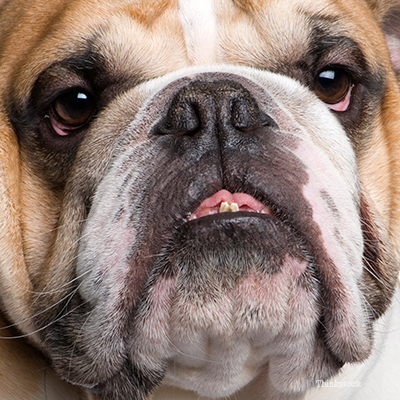
Some body types of dogs are prone to numerous and sometimes excessive folds and wrinkles of the skin. This can occur as a result of obesity or in some breeds can be a normal variation.
Dogs that are overweight may have areas of skin that are prone to friction or rubbing and if they lose weight may have residual excess skin that results in deep folds. These areas can present problems that arise from a combination of rubbing, heat and moisture that predispose these areas to skin infection or what we call “pyoderma.”
What breeds are affected?
In some breeds exuberant folds and wrinkles are a breed characteristic that is somewhat desirable but can present maintenance care problems – bulldogs are a good example. Bulldog breeds include the English Bulldog or British Bulldog, the American Bulldog, Olde English Bulldog and the French Bulldog. The English Bulldog was the fifth most popular breed in the United States in 2013 and the French Bulldog is quickly becoming one of the most popular breeds according to the American Kennel Club.
Other breeds that have shortened muzzles like the Boston Terrier, Pekingese, Shih Tzu, Pug and King Charles Spaniel often have very deep facial folds too.
These deep folds result from a lack of muscle beneath the skin and an excess of skin that develops into folds especially over the front of the face. These wrinkles and folds result in a warm and moist environment that can lead to the growth of bacteria and yeast that may invade the skin and result in infection. Antibiotics and local cleansing and drying may help but they do nothing to treat the underlying cause.
Other areas of the body like lip folds, armpit areas, peri-vulvar areas and excessive wrinkles around the tail base, sometimes called screw-tail, can also be affected.
What are the treatments for skin fold pyodermas?
Treatment involves regular, frequent cleansing of affected areas, keeping the area free of moisture and the use of a topical. The systemic use of antibiotics and anti-fungal agents can also help. If your dog is one of the breeds mentioned here and has problems with skin fold pyoderma it is important to have your veterinarian teach you to maintain these areas and to keep them as clean and dry as possible.
What is the prognosis of skin fold pyodermas?
With proper treatment infected areas will respond and the immediate prognosis is very good. Unfortunately, however, the underlying cause of deep wrinkles and folds still exists and there is a very high likelihood of repeat problems. Only with definitive treatments can you completely prevent the condition from returning.
How can skin fold pyodermas be prevented?
One step that is often overlooked is simple weight control. A couple pounds of weight reduction can do a lot to reduce the prominence of body folds. Cleaning often can also reduce the likelihood for infection. Wash affected areas with a mild soap and rinse very thoroughly and dry well. In my personal experience, use of a drying powder such as BFI Antiseptic powder will help keep the area dry and reduce bacterial contaminants. Gently clipping the hair from the area will help reduce moisture and bacteria.
Unfortunately, definitive prevention often involves surgery. Removal of deep facial folds, peri-vulvar fat tissue, lifting the vulva from a deep fold and surgery on the tail base to alleviate screw-tail are generally curative. While these surgeries are commonly elective they can do a great deal to improve your dog’s quality of life for years to come.
Ask your veterinarian to discuss these options with you.
Questions to ask your veterinarian
- Why is my Pekingese’ face always wet and smelly?
- My dog has a rash by her vulva that is recurrent. What can I do?
If you have any questions or concerns, you should always visit or call your veterinarian -- they are your best resource to ensure the health and well-being of your pets.
